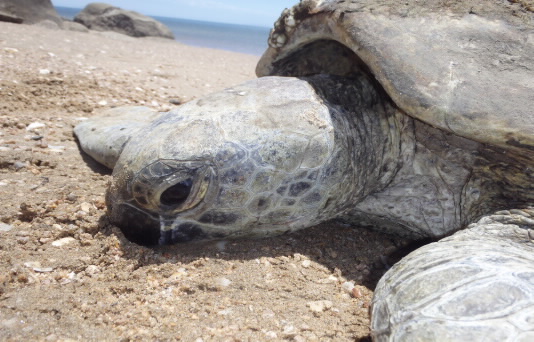Media Releases
Scientists hunt cause of mystery turtle deaths

Green turtle (Picture:© Christine Hof/WWF-Aus)
James Cook University researchers are trying to unravel the mystery of a 2012 mass stranding of green turtles in Upstart Bay, near Ayr in Queensland.
The number of green turtles stranding in the general area increased from five in 2009 to more than 100 animals in 2012. Scientists are now intensively monitoring in Upstart Bay, southeast of Ayr, to find out why.
The four-year project involves the JCU team collecting seagrass, algae and sediment. They will also set passive water samplers at turtle foraging sites, and during floods at the Burdekin River mouth.
Team member Dr Colette Thomas said they are looking for traces of metals.
“The presence of legacy metals in the catchment draining to Upstart Bay, and the possibility of turtles being exposed to metals such as cobalt, mercury and nickel, lead us to focus there.”
The World Wildlife Fund and Banrock Station Environmental Trust are sponsoring the research, which sees the JCU staff having to take some extraordinary precautions.
“To prevent accidental contamination of the samples, we must wear gloves, keep our hair tied away, keep downstream of the sample site, avoid sunscreen, and use a plastic boat,” said Dr Thomas.
“It is very easy to accidentally contaminate samples with metals. If we need to detect very small changes in relative metal levels, we would have to wear a full hazmat suit.”
Environmental metal levels are compared with metal levels measured in the turtles by University of Queensland researchers.
“If we see unexpectedly high levels of a particular metal in turtles, as well as in our forage sites samples, there is a strong chance that we have detected a contaminant of concern for turtles,” said Dr Thomas.
She said the team took the scientific approach of trying to rule out the possibility that contaminants related to human activity might be responsible for the mass strandings.
“But if contaminants of concern are detected we will attempt to trace them to their source for proper management.”
She said there were both legacy mines and natural potential metal sources in the upstream and adjoining catchments.
Contact: Dr Colette Thomas
E: Colette.thomas@jcu.edu.au
P: (07) 4781 5513